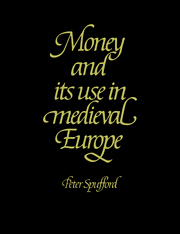Book contents
- Frontmatter
- Contents
- List of maps
- List of tables
- List of graphs
- Acknowledgements
- Introduction
- Part I Before the Commercial Revolution
- Part II The Commercial Revolution of the Thirteenth Century
- 5 New Silver c. 1160 – c. 1330
- 6 The Balance of Payments and the Movement of Silver
- 7 European Silver and African Gold
- 8 New Mints
- 9 Ingots of Silver
- 10 New Money
- 11 The Place of Money in the Commercial Revolution of the Thirteenth Century
- Part III The Late Middle Ages
- Conclusion
- Appendix I The Coins Most Commonly in Use in the Middle Ages
- Appendix II Money of Account
- Appendix III Production at Some Later Medieval Mints
- Bibliography
- Coin Index
- General Index
9 - Ingots of Silver
Published online by Cambridge University Press: 23 November 2009
- Frontmatter
- Contents
- List of maps
- List of tables
- List of graphs
- Acknowledgements
- Introduction
- Part I Before the Commercial Revolution
- Part II The Commercial Revolution of the Thirteenth Century
- 5 New Silver c. 1160 – c. 1330
- 6 The Balance of Payments and the Movement of Silver
- 7 European Silver and African Gold
- 8 New Mints
- 9 Ingots of Silver
- 10 New Money
- 11 The Place of Money in the Commercial Revolution of the Thirteenth Century
- Part III The Late Middle Ages
- Conclusion
- Appendix I The Coins Most Commonly in Use in the Middle Ages
- Appendix II Money of Account
- Appendix III Production at Some Later Medieval Mints
- Bibliography
- Coin Index
- General Index
Summary
Even if we had fairly detailed statistics of the increase in coined money minted in several countries of Europe during the thirteenth century, we would still not know how much money was in circulation, not only because of the problems posed by repeated reminting, but, much more, because major payments, both locally and internationally, continued to be made not in coin, but in silver ingots. Coin was only a part of the silver in circulation, and it is quite impossible to gauge how large or how small a part.
The use of ingots for large payments was by no means new in the twelfth century, but at the end of the century their availability and use naturally increased enormously, both in proportion to the overall increase of silver in circulation and also in parallel with the quantities minted into coin. For large payments, unminted silver, provided its fineness was known, was obviously more convenient than minted silver, which had to be counted out, or weighed, in the form of thousands, or even tens of thousands of separate coins.
This unminted silver travelled from the mining-areas of Europe to the more economically advanced areas in bars or ingots of a standard fineness. There is some evidence to suggest that they were also frequently of a standard weight, the mark, although the mark weight itself, of course, varied from place to place.
- Type
- Chapter
- Information
- Money and its Use in Medieval Europe , pp. 209 - 224Publisher: Cambridge University PressPrint publication year: 1988



